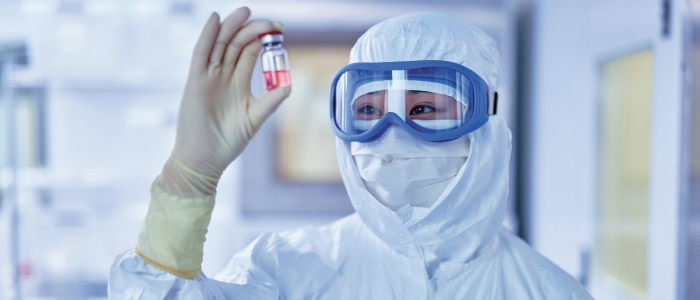
Most vaccine manufacturing processes depend on quality control at every step. Failures can be costly, dangerous, and compromise compliance. Cleanroom garments are necessary to protect both processes and products from contamination, while also protecting operators from the hazardous substances involved in manufacturing.
Vaccine manufacturing has been of paramount importance during the COVID-19 pandemic, and it remains a fast-growing industry. The manufacturing processes for vaccines are complex and consist of many steps. To ensure the highest quality for the finished products, there are strict quality assurance procedures in place, and protection must be ensured throughout all processes.
Operators represent the biggest source of contamination inside cleanrooms
Operator contamination can be reduced through training and impeccable hygiene, but it cannot be eliminated altogether. Proper use of cleanroom garments can effectively prevent particle contamination generated by operators in the cleanroom, acting as a barrier between the operator and the production environment. The revised EU GMP Annex 1 for the manufacture of sterile medicinal products states that protective clothing should retain particles shed by operators and should minimize shedding of garment fibers or particles.1 Sufficient cleanroom clothing is required during most steps of the vaccine manufacturing process to prevent contamination and ensure patient safety, as well as protect operators from hazardous substances. DuPont™ Tyvek® IsoClean® coveralls and accessories can be beneficial in ensuring clean vaccine manufacturing.
Advantages of Tyvek® fabric
For over 20 years, Tyvek® IsoClean® garments have been an excellent choice for a variety of processes in vaccine manufacturing because of their outstanding fabric design and performance. Tyvek® is made from high-density polyethylene filaments that are thermally bonded into a tight, homogeneous, and soft fabric that is breathable and has low-linting and strong barrier properties. This unique combination of barrier protection and breathability makes Tyvek® suitable for the cleanroom environment. Additionally, Tyvek® fabric offers the operator protection against hazardous particles down to 1.0 micron in size, aerosols, and nonhazardous light liquid splash.
Protection of the cleanroom and production
- Suitable for different cleanroom types (ISO Class 4-9 and GMP A/B, C/D)
- Barrier against contamination generated by the operators
- Low particle release
- Available in clean-processed & sterile options
Protection of the operator
- Repels aqueous liquids and liquid aerosols
- Provides biological protection
- Two-way barrier against particles
- Tear- and abrasion-resistant properties
Comfort of the operator
- Lightweight, soft, and breathable garment fabric
- Coveralls designed for operator comfort
- Clear gowning procedures
Compliance with QRM procedures and GMP Annex 1
GMP Annex 1 anticipates that all pharmaceutical manufacturing activities will be governed by quality risk management (QRM) principles and documented in the contamination control strategy (CCS).1 This is a proactive approach. It will no longer be enough to simply react to and correct detected contamination. Manufacturers will be expected to identify potential risks to quality, put in place technical and procedural means to control these risks, and aim for continuous improvements.
Cleanroom garment systems are a critical part of sterile and aseptic manufacturing. They must be managed under QRM principles to ensure GMP compliance and, ultimately, patient safety. Vaccine manufacturing involves a number of manual interventions and there may be some risk to operators. Operators must be equipped with appropriate personal protective equipment (PPE) whenever there is a risk to their health and safety.
Consistent performance
Regulators expect vaccine manufacturers to keep their vaccines free from contaminants at all times. Control of the contamination risk linked to operators will rely on the barrier performance of cleanroom garments. Tyvek® IsoClean® sterile cleanroom garments make this control easier. Since these garments are only used once, they offer consistent performance in Helmke drum tests and bacterial filtration efficiency. This is not the case for reusable cleanroom garments that are used, washed, dried, and sterilized multiple times. The performance of reusable garments is significantly reduced by repeated laundering cycles.
For single-use garments, the impact of gamma radiation on the polymer only occurs one time, so the properties are consistent. Average bacterial filtration efficiency of reusable garments is in a range of 64 to 69 percent, while average bacterial filtration efficiency of Tyvek® IsoClean® single-use garments is in a range of 98 to 99 percent.2
Peace of mind
Producing high-quality, innovative vaccines is a difficult and complicated task, and the anticipated need for a QRM-based approach with a documented contamination control strategy will not make it any easier. As DuPont is the manufacturer of both the Tyvek® material and the finished clean and sterile Tyvek® IsoClean® cleanroom garments, we control the value chain and can provide test data and certificates (such as lot-based certificates of sterility, irradiation, and compliance). This makes qualification and subsequent quality audits easier than with reusable cleanroom garments involving several value chain partners (PET filament manufacturer, fabric weaver, garment manufacturer, laundry, etc.). Also, the stock management of a single-use Tyvek® IsoClean® garment system is much easier than managing a reusable garment system, due to the avoidance of multiple washing and sterilization cycles; garment replacement or repairs; and complex invoice checking.
Flexible single-use solution
Vaccine manufacturing companies are growing fast, and manufacturing contracts are rarely synchronized with the five-year leasing contracts of most laundries. Single-use coveralls made from Tyvek® can offer more production flexibility, speed up production, and do not require infrastructure or laundry processes. Inventories can be adjusted to meet production needs. Single-use garments offer maximum flexibility and process protection, and are ideal for start-ups, small-batch production, single-use reactor production, and production requiring frequent adaptation and changes. Additionally, Tyvek® IsoClean® garments that have not been exposed to hazardous substances can be recycled in our Tyvek® Protective Apparel Recycling Program.
Protect your processes, products, and operators throughout each step of the vaccine manufacturing process with a single-use Tyvek® IsoClean® apparel ensemble that offers consistent performance and peace of mind.